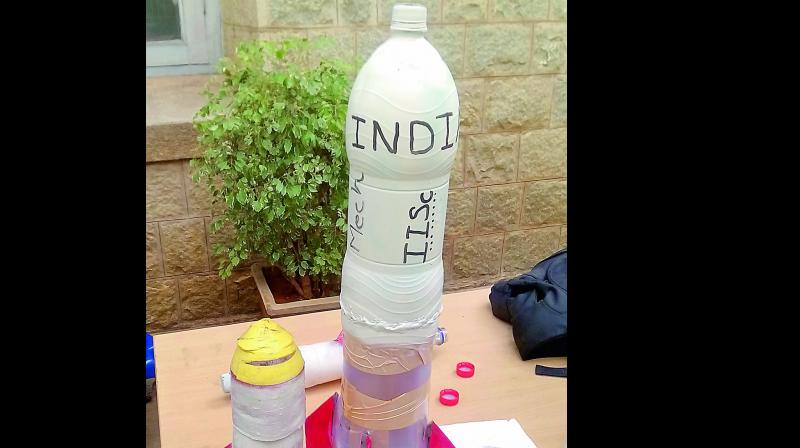Air-powered water rocket on display in Bengaluru
Navigation drones, mobile rocket launchers among other attractions put up by IISc.

Bengaluru: Water rockets, autonomously navigating drones and mobile rocket launchers were some of the major attractions at the annual Open Day organised by the Indian Institute of Science (IISc) on Saturday.
Thousands of students from various schools across the city witnessed recent discoveries of IISc researchers. The Water Rocket, designed and developed by the Department of Mechanical Engineering, is based on the principle of Newton’s third laws of motion.
The researchers behind the invention said that conventional rockets use the converging-diverging nozzle to expel gases at a high pressure and temperature, but the Water Rocket uses only liquid at room temperature employing a converging nozzle.
The term ‘water rocket’ is technically a misnomer since compressed air above the water column at high pressure is the true energy source. The water, which is nearly incompressible (and cannot be used as an energy source), is pressurised by the air and accelerated into the converging nozzle. The water jet is ejected at high downward velocity to produce thrust.
Autonomous navigation of drones
Another highlight was the autonomous navigation drones which are so precise that they can be landed on a mobile bot. The technology was developed by the researchers of Robert Bosch Centre for Cyber Physical Systems, who said that the drones can be used for medical transport, logistics and surveillance.
These flying machines have been developed for real world applications and can avoid obstacles to ensure precise landing. The researchers said that computer vision, image processing, visual serving and PID controller are the integral parts of the drones. “They can be monitored and landed in the precise place where one wishes,” the researchers said.
The wearable sensor device from the Kangaroo Mother Care by researchers from the Robert Bosch Centre for Cyber Physical Systems was the other attraction. The researchers said that the device can help the country beat the problem of premature and underweight babies.
The device can be fixed on the infant to collect data related to the infant that will be analysed by experts, who can alert the parents and medical staff of nearest hospitals on the health of the child.
The mobile rocket launcher, developed by Department of Aero Space Engineering, too attracted a lot of visitors. This launcher, developed by the Combustion, Gasiflacation and Propulsion Laboratory (CGPL), can be used under any condition and can be launched from any place.
The parabolic solar collector, developed by IISc researchers, is based on sunflowers which turn according to the movement of sun. Many a time, solar panels fail to use the energy optimally because of their angle.
The parabolic solar collectors avoid that problem by trying to collect the maximum amount of solar energy at any time, by positioning themselves at an optimum position.
UAV lab
The UAV lab of the Aerospace Engineering conducted competitions like drone racing and treasure hunt for clues to solve the puzzle using drones.

